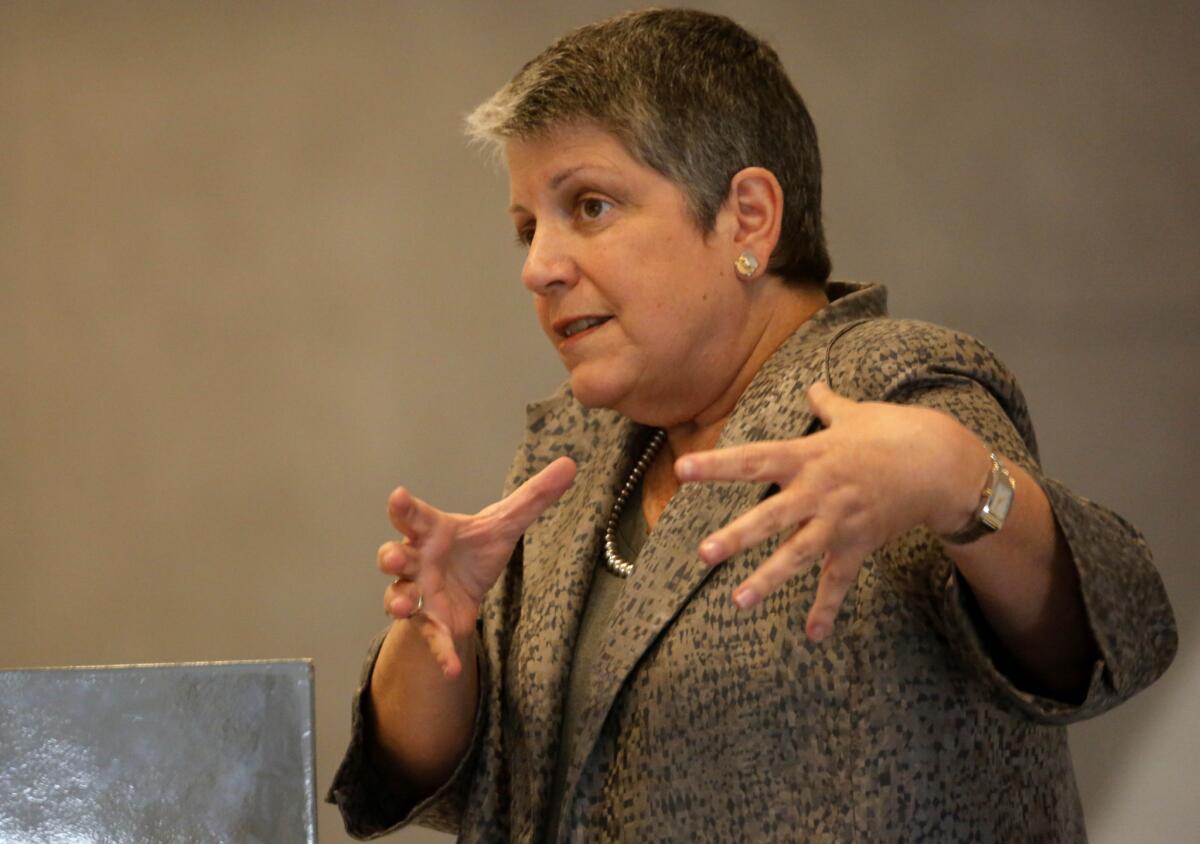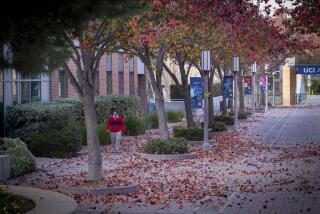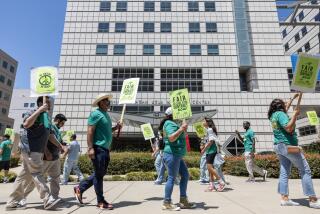UC officials scramble to prep housing for biggest boost in California students in years

University of California President Janet Napolitano speaks at a 2014 town hall.
The University of California is scrambling to make room for the largest enrollment boost of California undergraduates in years — 6,500 more for the fall 2016 term, with the most selective campuses taking the most new students.
UCLA, Berkeley, San Diego and Riverside will each accept 750 more students this year; systemwide, nearly 14% more state residents are expected to gain admission. That’s good news for nervous high school seniors and transfer students who competed against 206,000 others in another record-shattering year for UC applications for 2016.
The expansion has pressed officials to find more housing, hire additional faculty and expand support services. On Wednesday, UC President Janet Napolitano announced new efforts to build at least 14,000 more beds for undergraduate and graduate students by 2020.
“A key priority is to ensure this housing is and remains affordable to UC students,” Napolitano said at the UC Regents meeting in San Francisco. “Many of our campuses are located in some of the most expensive real estate markets in California.”
Campuses are already busy hiring new professors and adding additional undergraduate courses.
In November, regents approved Napolitano’s plan to boost enrollment of California students by 10,000 over the next three years, a response to criticism about the rising number of students from other states and countries taking UC seats. Out-of-state students pay triple the $12,200 in annual tuition Californians pay.
The Legislature approved $25 million for an additional 5,000 undergraduates this fall, but UC officials will actually admit 6,500 because enrollment dipped last year from 2014, the baseline year for the increase, according to UC spokeswoman Dianne Klein.
The funds, however, will pay for less than half the cost of educating the students. That prompted concerns at the meeting that educational quality could decline without more dollars.
Daniel Hare, a UC Riverside professor and chair of the Academic Senate, fretted that students could be deprived of more intimate, hands-on learning opportunities in teaching labs and performance studios that he said were crucial supplements to lectures.
“You’re slowly filling the balloon, and eventually it’s going to pop,” he said. “Everything we need to maintain for quality requires a commitment for resources that faculty are concerned are not being made.”
Join the conversation on Facebook >>
Mohsin Mirza, UC Student Assn. undergraduate committee chairman, told the regents that it was “highly irresponsible” to accept more students without making sure they had proper housing, classes, mental health services and other support.
He said one student was sleeping in the living room of his university housing, sharing space with two other students.
Julia Schemmer, a first-year UC Riverside student, said students are sitting on floors at her campus because classrooms are so crowded. Riverside is undergoing a faculty expansion, however, to lower class sizes from the high 20s to the low 20s, according to Provost Paul D’Anieri.
Officials at individual campuses also expressed concerns about how to pay for needed support for all the new students.
“It’s a huge challenge,” said Steve Olsen, UCLA vice chancellor and chief financial officer.
“The state is saying they want affordability but more access. Those are the marching orders we’ve been given, and we’re doing everything we can to make sure that that’s done in a way consistent with our goals for academic quality,” Olsen said.
As one short-term relief measure, Olsen said, UCLA will increasingly place three students in dorms designed for two as officials explore options to build or buy more housing. He said officials hope to eventually add 2,000 beds.
He also said UCLA could hire hundreds more professors, teaching assistants, academic counselors, mental health specialists and other staff members.
Similar planning is underway at UC Riverside. D’Anieri, the provost, said one of the biggest issues is a major math problem: How to calculate the number of admission offers it should extend in order to snare 750 additional students who will accept and enroll.
Officials have begun analyzing how many more courses will be needed. Some of the most popular freshman courses will probably be math, biology, chemistry and psychology, he said.
But he added that the campus already has begun expanding enrollment and, at the same time, adding faculty to shrink class sizes.
“Because this is something we’ve wanted to do, we’re very much on track to deal with it. I won’t call it a problem. I think it’s a great opportunity,” D’Anieri said. “We’re all about access — especially for California students.”
Napolitano said UC officials would begin touring all 10 campuses to assess housing needs. She said she hoped to accelerate the timetable for the new beds, with new construction and purchase of existing property largely financed by outside parties. Klein said those parties were private financiers, philanthropists and others.
In other actions, Napolitano asked that a proposal for an 8% hike in supplemental tuition for professional degrees in nursing be tabled for further study after several regents raised questions about it.
Several regents also pressed UC officials for greater efforts to expand the number of African American, Latino and other underrepresented students at UC.
For more education news, follow me @TeresaWatanabe
See the most-read stories this hour >>
ALSO
L.A. cracking down on racial bias by taxi cab drivers
Cal State faculty get support for possible strike from Los Angeles union members
Women claim Yoga guru Bikram Choudhury sexually assaulted them; he denies
UPDATE:
4:03 p.m: This article was updated with comments from UC President Janet Napolitano and others at the UC Regents meeting.
This article was originally posted at 5 a.m.
More to Read
Sign up for Essential California
The most important California stories and recommendations in your inbox every morning.
You may occasionally receive promotional content from the Los Angeles Times.











